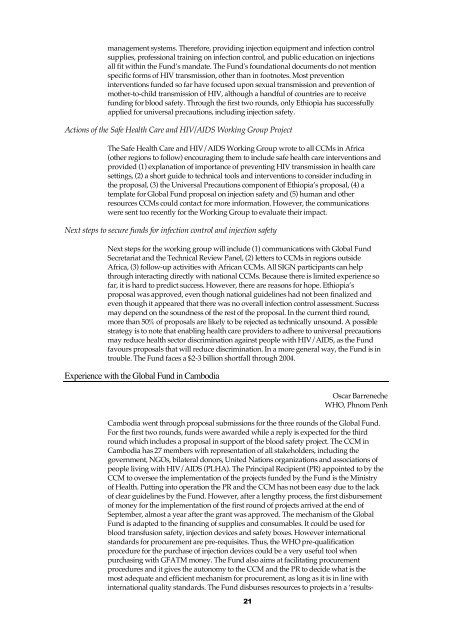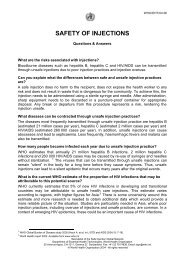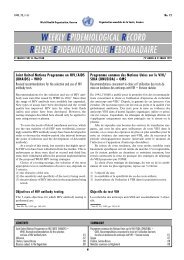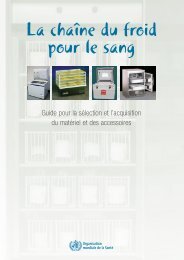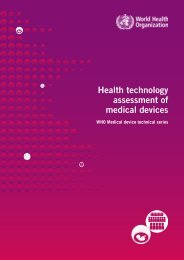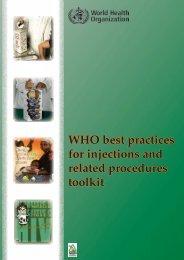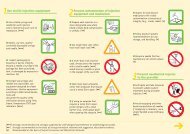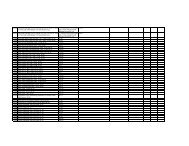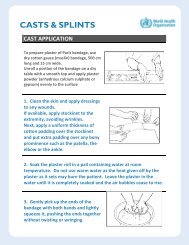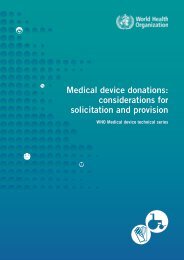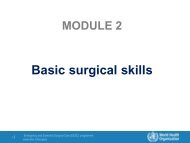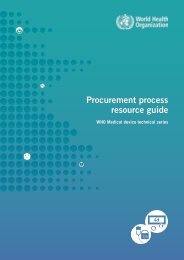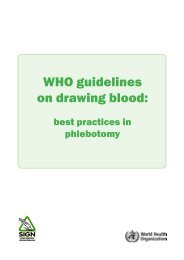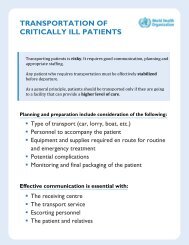SIGN meeting report 2003. - World Health Organization
SIGN meeting report 2003. - World Health Organization
SIGN meeting report 2003. - World Health Organization
Create successful ePaper yourself
Turn your PDF publications into a flip-book with our unique Google optimized e-Paper software.
management systems. Therefore, providing injection equipment and infection control<br />
supplies, professional training on infection control, and public education on injections<br />
all fit within the Fund’s mandate. The Fund's foundational documents do not mention<br />
specific forms of HIV transmission, other than in footnotes. Most prevention<br />
interventions funded so far have focused upon sexual transmission and prevention of<br />
mother-to-child transmission of HIV, although a handful of countries are to receive<br />
funding for blood safety. Through the first two rounds, only Ethiopia has successfully<br />
applied for universal precautions, including injection safety.<br />
Actions of the Safe <strong>Health</strong> Care and HIV/AIDS Working Group Project<br />
The Safe <strong>Health</strong> Care and HIV/AIDS Working Group wrote to all CCMs in Africa<br />
(other regions to follow) encouraging them to include safe health care interventions and<br />
provided (1) explanation of importance of preventing HIV transmission in health care<br />
settings, (2) a short guide to technical tools and interventions to consider including in<br />
the proposal, (3) the Universal Precautions component of Ethiopia’s proposal, (4) a<br />
template for Global Fund proposal on injection safety and (5) human and other<br />
resources CCMs could contact for more information. However, the communications<br />
were sent too recently for the Working Group to evaluate their impact.<br />
Next steps to secure funds for infection control and injection safety<br />
Next steps for the working group will include (1) communications with Global Fund<br />
Secretariat and the Technical Review Panel, (2) letters to CCMs in regions outside<br />
Africa, (3) follow-up activities with African CCMs. All <strong>SIGN</strong> participants can help<br />
through interacting directly with national CCMs. Because there is limited experience so<br />
far, it is hard to predict success. However, there are reasons for hope. Ethiopia’s<br />
proposal was approved, even though national guidelines had not been finalized and<br />
even though it appeared that there was no overall infection control assessment. Success<br />
may depend on the soundness of the rest of the proposal. In the current third round,<br />
more than 50% of proposals are likely to be rejected as technically unsound. A possible<br />
strategy is to note that enabling health care providers to adhere to universal precautions<br />
may reduce health sector discrimination against people with HIV/AIDS, as the Fund<br />
favours proposals that will reduce discrimination. In a more general way, the Fund is in<br />
trouble. The Fund faces a $2-3 billion shortfall through 2004.<br />
Experience with the Global Fund in Cambodia<br />
21<br />
Oscar Barreneche<br />
WHO, Phnom Penh<br />
Cambodia went through proposal submissions for the three rounds of the Global Fund.<br />
For the first two rounds, funds were awarded while a reply is expected for the third<br />
round which includes a proposal in support of the blood safety project. The CCM in<br />
Cambodia has 27 members with representation of all stakeholders, including the<br />
government, NGOs, bilateral donors, United Nations organizations and associations of<br />
people living with HIV/AIDS (PLHA). The Principal Recipient (PR) appointed to by the<br />
CCM to oversee the implementation of the projects funded by the Fund is the Ministry<br />
of <strong>Health</strong>. Putting into operation the PR and the CCM has not been easy due to the lack<br />
of clear guidelines by the Fund. However, after a lengthy process, the first disbursement<br />
of money for the implementation of the first round of projects arrived at the end of<br />
September, almost a year after the grant was approved. The mechanism of the Global<br />
Fund is adapted to the financing of supplies and consumables. It could be used for<br />
blood transfusion safety, injection devices and safety boxes. However international<br />
standards for procurement are pre-requisites. Thus, the WHO pre-qualification<br />
procedure for the purchase of injection devices could be a very useful tool when<br />
purchasing with GFATM money. The Fund also aims at facilitating procurement<br />
procedures and it gives the autonomy to the CCM and the PR to decide what is the<br />
most adequate and efficient mechanism for procurement, as long as it is in line with<br />
international quality standards. The Fund disburses resources to projects in a ‘results-


